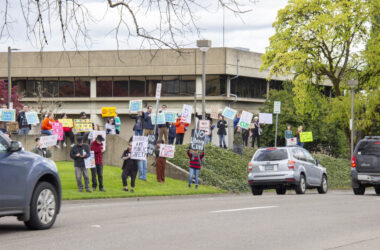
Gary Weaver, a transit operator with Cherriots, steps off of a freshly cleaned bus on Friday, May 22. (Amanda Loman/Salem Reporter)
Salem could begin charging for on-street parking downtown, supporting energy efficiency and weatherization for lower-income households (including renters) and small business owners, and adding trees in areas with low canopy.
Those are the most cost-effective strategies identified in Salem’s draft Climate Action Plan, a document created over the past year to help the city address climate change by reducing its pollution.
The plan was created amid a year of extreme weather events, from wildfires to an ice storm, drought and a deadly heat wave.
As those weather events are predicted to become increasingly common, Salem would have to take aggressive action to meet its stated goals.
Last October, the council adopted goals to cut the city’s greenhouse gas emissions in half by 2035 and become carbon neutral by 2050. That would mean removing greenhouse gases from the atmosphere to balance out remaining human-caused emissions.
During a Sept. 20 meeting, the Salem City Council was presented with two strategies to help the city reduce its pollution. Both strategies were included in the plan.
One would meet the city’s goals but be difficult to attain without more stringent regulation. The other would cut Salem’s emissions by about 60% by 2050 through actions that are more attainable, like increasing bus ridership, electric vehicle usage and transitioning to a zero-emissions bus fleet.
Under the more stringent scenario, the city would have to accomplish the actions in the first scenario and more.
It would have to stop gas-fueled semi-trailers and air traffic from entering the city, ensure a renewables-only electricity grid and require those with septic systems to join a centralized wastewater treatment system.
The city would also have to achieve zero waste, which is defined as diverting 90% of waste from landfills through waste reduction, composting, recycling and reusing.
“The actual path that Salem will take will undoubtedly look different as time goes on. Some of the emissions reductions could be accomplished in other ways and in different combinations. Technological and behavioral solutions that cannot yet be quantified may play an important role by 2050,” the plan said.
The plan notes that the city’s greenhouse gas emissions will reach lower levels in 2050 than they were in 2016 even if the city didn’t do anything.
“This is because of factors such as expected increases in energy efficiency, renewable energy, and the use of electric vehicles,” it said.
More than half of Salem’s emissions come from transportation, according to Salem’s greenhouse gas inventory.
Salem is expected to see warming temperatures, changing precipitation and increased wildfire risk.
The city is projected to see an increased number of extreme heat days, from seven per year to 33 by 2050. The number of days over 100 degrees is predicted to increase from one to six in that same period, the plan stated.
Extreme fire danger days will double by mid-century, increasing from a historic average of 10 to 20 each year.
The hotter and drier conditions are likely to cause more frequent droughts, it explained.
About 75 members of the community and task force members contributed 221 ideas to identify a vision for a resilient Salem in 2050.
The Climate Action Plan Task Force was made up of 33 people from a range of fields, including the school district, businesses, social services and three city councilors.
Implementing the plan includes hiring a full-time coordinator, establishing a working group, tracking and reporting emissions, and updating the Climate Action Plan every five years.
The task force is holding its final meeting on Oct. 27 and a final draft will be presented to council on Dec. 6.
People have until Nov. 5 to comment on the plan. Comments can be submitted online at SalemClimateActionPlan.com/review-draft-cap, by email at [email protected], or by mail to Salem Climate Action Plan Comments, 555 Liberty St SE, Suite 325, Salem, Oregon, 97301-3515.
Contact reporter Saphara Harrell at 503-549-6250, [email protected].
JUST THE FACTS, FOR SALEM – We report on your community with care and depth, fairness and accuracy. Get local news that matters to you. Subscribe to Salem Reporter starting at $5 a month. Click I want to subscribe!









